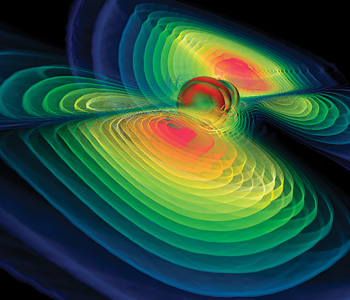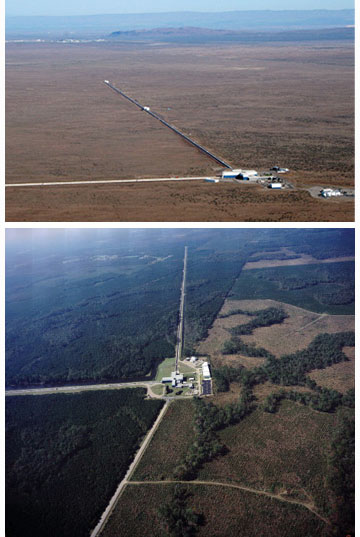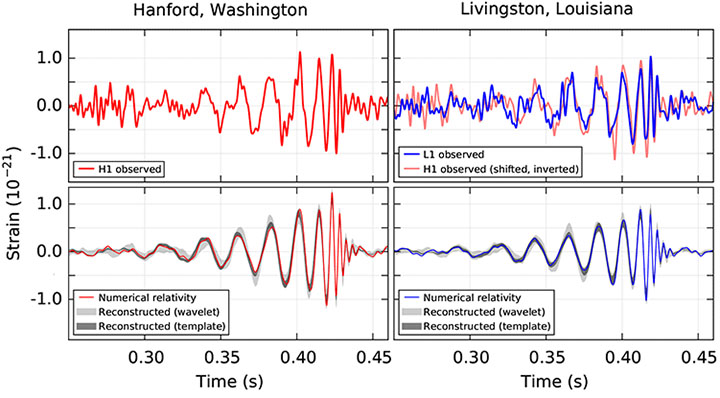
Computer simulation of colliding black holes. A similar collision, more than a billion light years away, released the enormous energy picked up by the LIGO team. [Image: Bernd Brügmann, University of Jena, Germany]
Short version: Einstein was right, and it’s pretty amazing.
Somewhat longer version: In a landmark result, a international coalition of scientists has announced that the Laser Interferometer Gravitational-Wave Observatory (LIGO) in North America has detected gravitational waves generated by the violent merger of a pair of black holes that crashed together more than a billion years ago (Phys. Rev. Lett., doi: 10.1103/PhysRevLett.116.061102).
The detection of the famously elusive waves—the last remaining major test of general relativity—marks the vindication of a half-century quest. It also potentially opens an entirely new observational window on some of the universe’s most exotic events.
New and improved LIGO

The LIGO facilities in Hanford, Washington (top), and Livingston, Louisiana (bottom), showing the long interferometer arms.
The detection took place at “Advanced LIGO,” a sprawling pair of facilities located in the states of Washington and Louisiana, USA. Advanced LIGO was unveiled in mid-2015 after years of redesign and improvement to boost the sensitivity of the previous model, launched in 2003 (see “LIGO: Finally Poised to Catch Elusive Gravitational Waves?,” OPN, March 2015).
In a very real sense, the success of Advanced LIGO is a success enabled by optical and photonic technology—indeed, a success almost unthinkable without that technology. It also constitutes a remarkable example of sustained scientific commitment. The original concept of using a Michaelson interferometer was proposed nearly 50 years ago, in 1967, by Rainer Weiss of the Massachusetts Institute of Technology, who noted that a gravitational wave passing through such a device would tend to shrink one interferometer arm and extend the other. To pick up a detectable signal, however, the device would have to be of gargantuan scale, with laser interferometer arms miles in length.
The idea gained traction in the physics community, and 22 years later Weiss, along with physicists Ronald Drever, Kip Thorne, and Rochus Vogt, would cofound LIGO in 1989. That was followed by a 14-year effort to build and launch the original LIGO, in turn succeeded by an effort, beginning in 2008, to improve the sensitivity and noise damping at the two observatories. Underwriting the work was a decades-long funding commitment by the U.S. National Science Foundation.
The result, Advanced LIGO, is an instrument of mind-blowing sensitivity, with perpendicular pairs of 4-km-long laser interferometer arms capable of detecting strains on the order of 4×10–22—or, on the scale of the facility, one-one-thousandth of the diameter of a proton.
Fast out of the gates
Weiss and Thorne were on hand for the press conference on the discovery, as was OSA Fellow and Caltech scientist David Reitze, who took the helm as executive director of LIGO several years ago, and Gabriela González, a professor of physics at Louisiana State University and the spokesperson for the LIGO Scientific Collaboration.
The observation reported at the 11 February presser was actually made on 14 September 2015, almost exactly 100 years after Einstein first published the field equations of general relativity. Remarkably—almost as if the upgraded new facilities were straining at the reins, itching to strut their stuff—the detection occurred only a few days after Advanced LIGO came fully online, during its engineering test phase, before the scientific program even officially began.
After that detection—perhaps recalling the experience of a previous report of gravitational-wave discovery in 2014 with the BICEP2 telescope that has subsequently been widely questioned—the international team took months analyzing the data to boost their confidence that the signal was real. One confirmation came from the fact that 0.2-second signal, first detected in the Louisiana observatory, showed up right on schedule at the Washington facility a few milliseconds later. Another strong line of evidence came from the near-perfect agreement found between the signals at the two widely separated facilities (an indication that the signal wasn't the product of local noise or vibrations), and the equally stunning alignment between the LIGO data and the signal predicted from numerical modeling of a black-hole collision and merger of a specific size:

The signals at the two LIGO facilities showed remarkable agreement both with each other (top) and with numerical simulations of black-hole collision (bottom). [Image: B.P. Abbott et al., Phys. Rev. Lett., doi: 10.1103/PhysRevLett.116.061102]
A new window on exotic astrophysics
Notwithstanding the excitement of the LIGO result as perhaps the crowning confirmation of general relativity, the scientific community is equally enthused by what lies ahead. LIGO co-founder Kip Thorne of Caltech noted that—unlike radio, X-ray, and optical astronomy—gravity waves are not electromagnetic in nature, and thus potentially represent an entirely new way of looking at astrophysical events. That new gravity's-eye view will come not only from LIGO, but from other gravitational-wave observatories slated to come on line in the next several years, including Advanced Virgo, an upgrade of a facility in Italy, and KAGRA, a Japanese project under construction.
“We’ll see gravitational waves from spinning neutron stars,” Thorne said, “gravitational waves from black holes tearing neutron stars apart, gravitational waves from neutron stars colliding.” There is even the hope, Thorne said, of finding gravitational waves from more exotic phenomena such as “cosmic strings” tied to the inflation of the universe during the big bang. “Gravitational waves are so radically different from electromagnetic waves,” Thorne said, “that I think we can be rather sure that we will see big surprises.”
